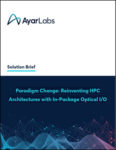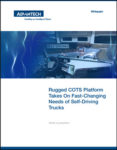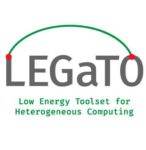In this sponsored post, our friend John Spiers, Chief Strategy Officer at Liqid, discusses how composable disaggregated infrastructure (CDI) solutions are emerging as a solution to roadblocks to advancing the mission of high-performance computing. CDI orchestration software dynamically composes GPUs, NVMe SSDs, FPGA, networking, and storage-class memory to create software-defined bare metal servers on demand. This enables unparalleled resource utilization to deliver previously impossible performance for AI-driven data analytics.
Paradigm Change: Reinventing HPC Architectures with In-Package Optical I/O
In this white paper, our friends over at Ayar Labs discuss an important paradigm change: reinventing HPC architectures with in-package optical I/O. The introduction of in-package optical I/O technology helps HPC centers accelerate the slope of compute progress needed to tackle ever-growing scientific problem sizes and HPC/AI convergence. Ayar Labs expects to not only see its technology extend the traditional type of architecture to put the HPC industry back on track, but also result in an inflection point that fundamentally changes the slope of the compute performance efficiency curve. The key will be enabling converged HPC/AI centers to build systems with disaggregated CPUs, GPUs, FPGAs and custom ASICs interconnected on equal footing.
Xilinx Names Hasmukh Ranjan Chief Information Officer
Xilinx has announced that Hasmukh Ranjan has joined the company as chief information officer. As CIO, Hasmukh will lead Xilinx’s information technology group and drive internal IT strategy, systems and processes in support of Xilinx’s mission to “build the adaptable, intelligent world.” Hasmukh joins Xilinx from Synopsys, where he served as the company’s CIO and […]
Rugged COTS Platform Takes On Fast-Changing Needs of Self-Driving Trucks
This white paper by Advantech, “Rugged COTS Platform Takes On Fast-Changing Needs of Self-Driving Trucks” discusses how the fast-changing needs of self-driving trucks are forcing compute platforms to evolve. Advantech and Crystal Group are teaming up to power that evolution based on AV trends, compute requirements, and a rugged COTS philosophy converging for breakthrough innovation in self-driving truck designs.
2020 Predictions from Radio Free HPC
In this podcast, the Radio Free HPC team lays out their tech predictions for 2020. “Henry predicts that we’ll see a RISC-V based supercomputer on the TOP500 list by the end of 2020 – gutsy call on that. This is a double down on a bet that Dan and Henry have, so he’s reinforcing his position. Dan also sees 2020 as the “Year of the FPGA.”













